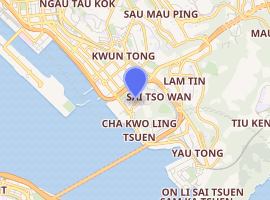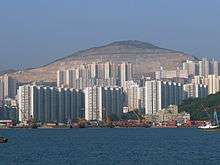Laguna City
Laguna City (Chinese: 麗港城) is one of the earliest large-scale private-housing estates built in Kwun Tong, Kwun Tong District, in Kowloon, Hong Kong. It was developed jointly by Cheung Kong Holdings and Hutchison Whampoa Property[3] and completed in the early 1990s.
| Laguna City | |
|---|---|
麗港城 | |
 Laguna City, 2018 | |

| |
| General information | |
| Status | Complete |
| Type | Residential |
| Location | 99 Cha Kwo Ling Road Sai Tso Wan, Kowloon, Hong Kong |
| Coordinates | 22.30599°N 114.22767°E |
| Completed | Block 1-7, 13-16: December 1990 Block 24-31: May 1991 Block 8, 17: December 1991 Block 32-38: February 1992 Block 9, 18: May 1993 Block 10-12, 19-23: December 1994 |
| Management | Citybase Property Management Ltd. (wholly owned subsidiary of Cheung Kong (Holdings) Limited) |
| Technical details | |
| Floor count | 25-28 |
| Design and construction | |
| Developer | Cheung Kong Holdings, Shell & Hutchison Whampoa Property |
| Other information | |
| Number of rooms | 8072 |
| References | |
| [1] [2] | |

Location
Laguna City is built along Lam Tin's waterfront. Part of Laguna City is built on reclaimed land. The development is adjacent to Cha Kwo Ling Village, one of the last squatter villages in Hong Kong.[4]
History
In the late 1980s, Cheung Kong acquired two pieces of land in Lam Tin, one being a former Shell oil depot, the other above the newly built Lam Tin MTR Station and bus terminus, and developed them into Laguna City and Sceneway Garden respectively.[5][6] Laguna City was completed in 1991 and Sceneway Garden was completed in 1992.
Description
Laguna City consists of four phases, totalling 38 towers at its 1991 completion. There are 3 private roads in Laguna City, which are Laguna Street in phase 1 and 4, Laguna Street East in phase 2 and Laguna Street South in phase 3. Phases 1, 2 and 4 of Laguna City are managed by the same company, while phase 3 has an independent management authority. Similarly, Phases 1, 2 and 4 share an owners' committee, whereas Phase 3 has its own.[1][2] Census data indicate that Laguna City had a population of 23,354 in 2011.[7]
Built together with Laguna City was Laguna Park, which was completed in 1994 and then handed over to the Urban Council, now the Leisure and Cultural Services Department. Laguna Park has a total area of 30,000 sq m (320,000 ft²).
- Phase 2 & 3, Laguna City with Victoria Harbour background.
- Interior of the Laguna Plaza shopping centre.
- Laguna Park entrance
Facilities
- 3 shopping centres, which are Laguna Plaza, Centre de Laguna and Laguna Arcade.
- 2 resident club house
- 1 park
- a few children playgrounds and jogging trails
- 1 pet park located near Laguna City in Kwun Tong Ferry Pier Square.
- 5 tennis court
- 2 basketball court
- 1 soccer pitch
- 1 public transport interchange with 3 bus routes and 2 minibus routes.
- 2 kindergartens
- Hong Kong Public Libraries mobile library Laguna City stop (Next to Laguna City Clubhouse 1)
Transportation
Railway
Kwun Tong Line Lam Tin Station exit D1
Buses and minibuses
Buses
| Kowloon & New Territories buses | ||||
|---|---|---|---|---|
| Route | Departure | Direction | Destination | Service Format |
| 40 | Tsuen Wan (Nina Tower) | ↔ | Laguna City | |
| 219X | Laguna City | ↺ | Tsim Sha Tsui | |
| Cross Harbour buses | ||||
|---|---|---|---|---|
| Route | Departure | Direction | Destination | Service Format |
| 621 | Laguna City | ↔ | Central(Hong Kong Station) | weekdays peak hour only |
| Lantau & Airport buses | ||||
|---|---|---|---|---|
| Route | Departure | Direction | Destination | Service Format |
| E22 | Lam Tin (North) | ↔ | Airport AsiaWorld-Expo | |
| E22X | Yau Tong | ↔ | Airport AsiaWorld-Expo | weekdays peak hour only |
Minibuses
| Kowloon minibuses | ||||
|---|---|---|---|---|
| Route | Departure | Direction | Destination | Service Format |
| 23B | Kwun Tong (Yan Oi Court) | ↔ | Cha Kwo Ling | |
| 23C | Sceneway Garden | ↺ | Yau Tong Station | |
| 23M | Kwun Tong (Yan Oi Court) | ↔ | Sceneway Garden | |
| 23S | Laguna City | ↔ | Sceneway Garden | weekdays morning peak hour only |
| 69 | Laguna City | ↺ | Kowloon City (Lion Rock Road) | |
| 69A | Laguna City | ↺ | Mong Kok (Embankment Road) | |
See also
- South Horizons, a private housing estate at Ap Lei Chau, was built from 1991 to 1995 by Hutchison Whampoa, partially on the former site of a Shell oil depot.
- Sceneway Garden, a private housing estate next to Laguna City, both connected by the Lam Tin MTR Station.
References
- Laguna City Phase 1,2&4 Resident Website
- Laguna City Phase 3 Resident Website (Chinese only)
- Hutchinson Whampoa Limited: Property Development Archived 17 April 2012 at the Wayback Machine
- Ng, June (14 May 2010). "Still Standing". HK Magazine. Archived from the original on 29 January 2011. Retrieved 13 May 2010.
- Market Behaviour of Developers Archived 3 February 2007 at the Wayback Machine – Consumer Council. Retrieved 18 February 2007.
- Leung, Sum-cheung (1996). Planning in Hong Kong for industrial relocation (Master of Science in Urban Planning thesis). University of Hong Kong. Retrieved 15 September 2014.
- 2011 Population Census: Fact Sheet for Laguna City in Kwun Tong District Council District District. For the purpose of the 2011 census, each of the "Major Housing Estates", among which South Horizons was listed, had its own census data entry. Such estates were thus defined: "A group of residential buildings developed by the same developer (either in the public sector or in the private sector) in one or more phases in a neighbourhood and with at least 3,000 residents or 1,000 domestic households in 2011."
External links
| Wikimedia Commons has media related to Laguna City. |
- Emporis entry
- S.K. Hui, A. Cheung, J. Pang, "A Hierarchical Bayesian Approach for Residential Property Valuation:Application to Hong Kong Housing Market", International Real Estate Review, 2010 Vol. 13 No.1: pp. 1–29